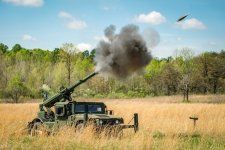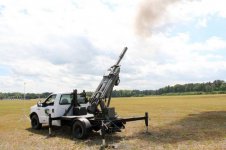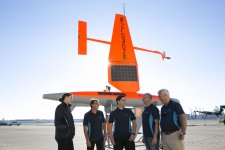- Reaction score
- 33
- Points
- 560
Shrinking a 105mm howitzer with its recoil system down to the point you can have a self propelled artillery piece mounted on a HMMVW or similar vehicle. the reduced crew is a nice touch as well. Something to consider if we want to continue to use 105mm howitzers for the Reserve Artillery park:
http://www.popularmechanics.com/military/weapons/a28288/hawkeye-humvee-mounted-howitzer/
http://www.popularmechanics.com/military/weapons/a28288/hawkeye-humvee-mounted-howitzer/
This Humvee-Mounted Howitzer Is Here To "Shoot and Scoot"
The Hawkeye Mobile Weapon System can fire and then move at a moment's notice.
By Kyle Mizokami
Sep 20, 2017
1.3k
A new self-propelled howitzer system meets a Humvee—or a Ford F-250 pickup truck—with a 105-millimeter howitzer for an artillery system capable of rapidly moving from one firing position to another. The result is the Hawkeye,a new artillery system that can not only keep up with fast-moving friendly forces but dodge attempts by enemy forces to shut it down.
Howitzers are artillery pieces designed to engage targets out of sight. Like other so-called "indirect fire" systems such as mortars, howitzers fire a heavy projectile at targets miles away. A major problem with indirect fire weapons is that they generate a huge amount of recoil, making it necessary to mount them on heavy vehicles equipped with stabilizers that dig into the dirt, bracing the entire vehicle.
Mandus Group, a defense contractor that specializes in field artillery maintenance, figured out that the key to reducing howitzer weight was to reduce recoil. Once that was accomplished, a howitzer could be parked on top of much lighter vehicles. At 2,550 pounds, Mandus claims the Hawkeye is the world's lightest self-propelled howitzer.
The Hawkeye's hydraulic recoil-dampening system reduces recoil by seventy percent. This makes it possible for 105-millimeter howitzers, which used to be mounted in armored vehicles, to fit on a flatbed M1152A1 Humvee, a trailer, and even a Ford F-250 pickup. A single button retracts the hydraulic stabilizers, and the Hawkeye is ready to hit the road just thirty seconds later.
The ability to pack up everything and move quickly is not just useful to support friendly forces. Although artillery typically stays far behind friendly lines, howitzers like Hawkeye are routinely targeted in wartime by so-called "counterbattery" missions conducted by an adversary's own artillery. Counterbattery relies on sound-locating equipment or radar to detect the point of origin of incoming artillery rounds, which is then showered with indirect fire.
The key to staying in the fight and not getting blown up is what artillerymen call "shoot and scoot" —firing from one position, moving, and then firing from another. The faster an artillery unit can displace to its next firing position, the better its chances of survival.
Hawkeye can fire up to eight 105-millimeter rounds a minute for three minutes, meaning a battery of six vehicles can rain down 144 105-millimeter shells on the enemy before the gun barrel gets so hot it needs a rest. It can fire high explosive, illumination, and smoke rounds to a range of 7.2 miles. It can fire rocket assisted projectiles that sacrifice payload for a rocket motor that increases effective range to 12.2 miles.
Hawkeye could be very useful for U.S. Army light infantry brigades and Marines, and both services have reportedly shown interest. The Hawkeye is currently being exhibited at the Modern Day Marine trade show at Quantico, Virginia. It is scheduled to strut its stuff next week at Camp Atterbury, Indiana and later Fort Sill, Oklahoma, the home of the U.S. Army artillery branch.




